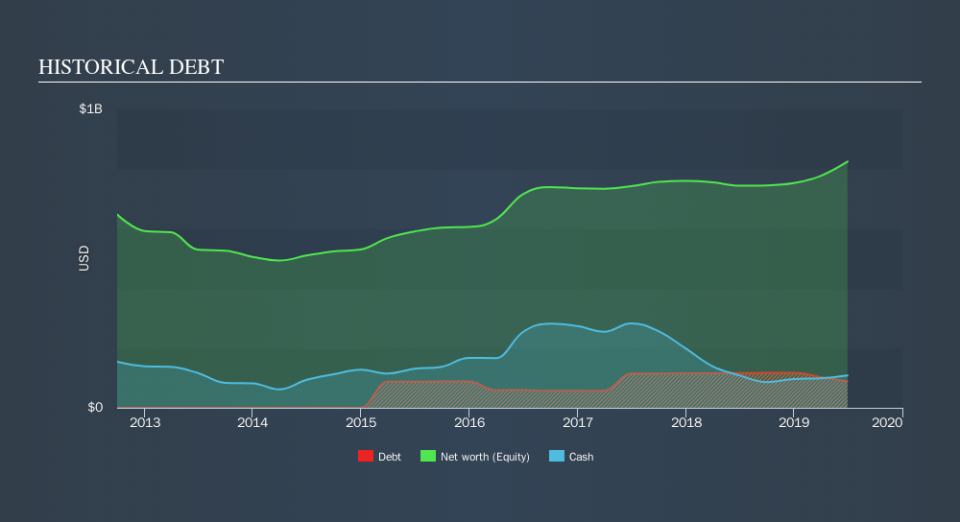Here's Why SEMAFO (TSE:SMF) Can Manage Its Debt Responsibly

Some say volatility, rather than debt, is the best way to think about risk as an investor, but Warren Buffett famously said that 'Volatility is far from synonymous with risk.' So it might be obvious that you need to consider debt, when you think about how risky any given stock is, because too much debt can sink a company. We note that SEMAFO Inc. (TSE:SMF) does have debt on its balance sheet. But is this debt a concern to shareholders?
Why Does Debt Bring Risk?
Debt assists a business until the business has trouble paying it off, either with new capital or with free cash flow. Part and parcel of capitalism is the process of 'creative destruction' where failed businesses are mercilessly liquidated by their bankers. While that is not too common, we often do see indebted companies permanently diluting shareholders because lenders force them to raise capital at a distressed price. By replacing dilution, though, debt can be an extremely good tool for businesses that need capital to invest in growth at high rates of return. When we think about a company's use of debt, we first look at cash and debt together.
See our latest analysis for SEMAFO
How Much Debt Does SEMAFO Carry?
You can click the graphic below for the historical numbers, but it shows that SEMAFO had US$88.5m of debt in June 2019, down from US$141.0m, one year before. However, its balance sheet shows it holds US$108.9m in cash, so it actually has US$20.4m net cash.
How Healthy Is SEMAFO's Balance Sheet?
We can see from the most recent balance sheet that SEMAFO had liabilities of US$148.2m falling due within a year, and liabilities of US$144.9m due beyond that. On the other hand, it had cash of US$108.9m and US$51.4m worth of receivables due within a year. So it has liabilities totalling US$132.8m more than its cash and near-term receivables, combined.
Given SEMAFO has a market capitalization of US$1.08b, it's hard to believe these liabilities pose much threat. But there are sufficient liabilities that we would certainly recommend shareholders continue to monitor the balance sheet, going forward. While it does have liabilities worth noting, SEMAFO also has more cash than debt, so we're pretty confident it can manage its debt safely.
It was also good to see that despite losing money on the EBIT line last year, SEMAFO turned things around in the last 12 months, delivering and EBIT of US$98m. There's no doubt that we learn most about debt from the balance sheet. But it is future earnings, more than anything, that will determine SEMAFO's ability to maintain a healthy balance sheet going forward. So if you're focused on the future you can check out this free report showing analyst profit forecasts.
But our final consideration is also important, because a company cannot pay debt with paper profits; it needs cold hard cash. While SEMAFO has net cash on its balance sheet, it's still worth taking a look at its ability to convert earnings before interest and tax (EBIT) to free cash flow, to help us understand how quickly it is building (or eroding) that cash balance. Looking at the most recent year, SEMAFO recorded free cash flow of 42% of its EBIT, which is weaker than we'd expect. That's not great, when it comes to paying down debt.
Summing up
Although SEMAFO's balance sheet isn't particularly strong, due to the total liabilities, it is clearly positive to see that it has net cash of US$20m. So we are not troubled with SEMAFO's debt use. We'd be motivated to research the stock further if we found out that SEMAFO insiders have bought shares recently. If you would too, then you're in luck, since today we're sharing our list of reported insider transactions for free.
When all is said and done, sometimes its easier to focus on companies that don't even need debt. Readers can access a list of growth stocks with zero net debt 100% free, right now.
We aim to bring you long-term focused research analysis driven by fundamental data. Note that our analysis may not factor in the latest price-sensitive company announcements or qualitative material.
If you spot an error that warrants correction, please contact the editor at editorial-team@simplywallst.com. This article by Simply Wall St is general in nature. It does not constitute a recommendation to buy or sell any stock, and does not take account of your objectives, or your financial situation. Simply Wall St has no position in the stocks mentioned. Thank you for reading.

 Yahoo Finance
Yahoo Finance 
